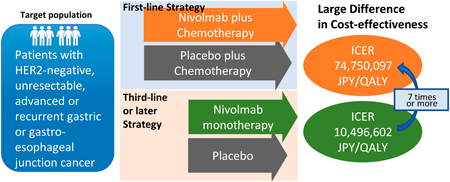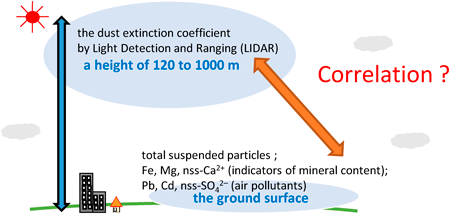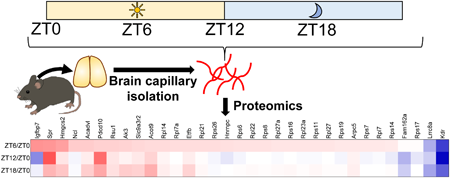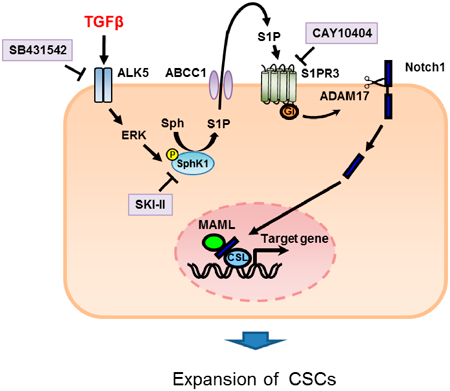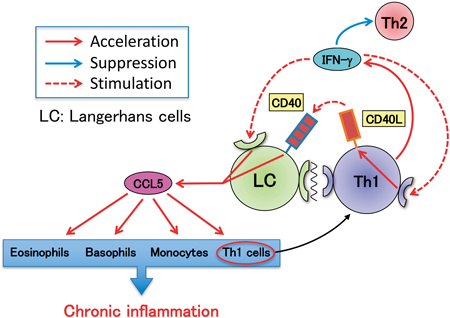-
Volume 45 (2022) Issue 8 Pages 1172-1179Nmu/Nms/Gpr176 Triple-Deficient Mice Show Enhanced Light-Resetting of Circadian Locomotor Activity Read moreEditor's pick
Circadian clock disruption has been linked to diseases ranging from metabolic syndrome to cancer. Therefore, the circadian system has become an attractive target for research and clinical care innovations. The authors show that the orphan G-protein-coupled receptor Gpr176 is involved in light entrainment of the circadian clock through a mechanism requiring two related neuropeptides, neuromedin U and neuromedin S. It is suggested by the authors that simultaneous modulation of these neuropeptides and Gpr176 may constitute a potential therapeutic option for modulating the circadian clock.
-
Volume 45 (2022) Issue 7 Pages 806-812Health Effects and Safety Assurance of Nanoparticles in Vulnerable Generations Read moreEditor's pick
Despite the usefulness of nanoparticles, there are now safety concerns about their use. Therefore, the importance of evaluating the safety of vulnerable generations such as pregnant women and infants, who are highly sensitive to chemical substances, has been pointed out worldwide. From this perspective, to analyze the risk from nanoparticles to vulnerable generations, nano-safety science and nano-safety design research has been conducted. The findings of these studies will lead not only to develop a nanotechnology that will enable the sustainable use of nanoparticles; they will also contribute to future developments in the field of health science.
-
Editor's pick
Recently, therapeutic drug monitoring is recommended for many drugs even though the procedure is not covered by health insurance. This Current Topic focuses on four areas: (1) anticancer drugs, (2) anti-infective agents, (3) antipsychotics/antidepressants, and (4) antibody drugs. Among the drugs that are not approved for insurance coverage in Japan, the drugs for which TDM is recommended and drugs that are likely to be approved in the future are summarized in a review, which include their pharmacokinetic characteristics and the usefulness of TDM.
-
Volume 45 (2022) Issue 7 Pages 851-855More than 370-Fold Increase in Antibody Affinity to Estradiol-17β by Exploring Substitutions in the VH-CDR3 Read moreEditor's pick
Antibodies that specifically target biomarkers are essential in clinical diagnosis. Genetic engineering has assisted in designing novel antibodies that offer greater antigen-binding affinities, thus providing more sensitive immunoassays. Authors have succeeded in generating a single-chain Fv fragment (scFv) targeted estradiol-17b (E2) with more than 370-fold improved affinity (Ka 3.2 ´ 1010 M-1), based on a strategy focusing the complementarity-determining region 3 in the VH domain (VH-CDR3). This improvement is the greatest reported for mutagenesis targeting anti-steroid antibodies. The scFv mutant enabled an enzyme-linked immunosorbent assay that provided sensitive dose-response curves for determining E2, the midpoint of which was 4.46 pg/assay.
-
Volume 45 (2022) Issue 7 Pages 881-887Hospital-Wide Surveillance of Fracture Risk Assessment by Both FRAX and Medication Patterns in Acute Care Hospital Read moreEditor's pick
Fracture Risk Assessment Tool (FRAX) is a well-known scoring system for predicting the probability of fragility fractures (FF). However, among the factors used in FRAX, glucocorticoid is the only medication factor. Authors assessed the risk of FF at each clinical department using FRAX and medication patterns. As a result, the departments included in the high-risk group by FRAX were not necessarily the same as the departments included in the top group, based on the administered medications. Authors recommend the use of FRAX together with prescribed medications on hospital-wide surveillance of fracture risk assessment.
-
Editor's pick
For the patient, the national health insurance of Japan is a wonderful system which can be proud to the world. Efficiency of medical care is an important issue to make this system sustainable into the future. Nivolumab, a breakthrough cancer drug, is widely effective, but its high price raises efficiency concerns. Authors performed model-based cost-effectiveness analyses in first-line and late-line treatment for advanced gastric cancer. The first-line treatment had an incremental cost-effectiveness ratio of more than 7 times that of the late-line treatment. Authors showed challenges between economics and best practices in healthcare.
-
Volume 45 (2022) Issue 6 Pages 703-708Effects of Concomitant Administration of PXR Ligand Drugs on the Anticoagulant Effects of Warfarin Read moreEditor's pick
Changes in drug-metabolizing activity via pregnane X receptor (PXR) is one of the mechanisms involved in drug-drug interactions. The authors reported cases in which the anticoagulant effects of warfarin were reversibly attenuated by the concomitant administration of rifampicin or bosentan, which are potent PXR ligands. However, no recovery of the response to warfarin was observed in the patients switched from bosentan to macitentan, which is considered not to activate PXR in clinical settings. The authors describe the importance of long-term monitoring and additional examinations to clarify the sustained mechanism for the drug interaction with warfarin, when switching from bosentan to macitentan.
-
Volume 45 (2022) Issue 6 Pages 709-719Comparison of the Concentration of Suspended Particles and Their Chemical Composition near the Ground Surface and Dust Extinction Coefficient by LIDAR Read moreEditor's pick
The dust extinction coefficient measured by light detection and ranging (LIDAR) has been used as an indicator of exposure to Asian dust in many epidemiological studies; however, few reports exist which explore the relationship between the dust extinction coefficient and the distribution of airborne particles near the ground surface. In this study, authors repot that the dust extinction coefficient is a useful indicator of Asian dust near the ground surface; however, as harmful air pollutants occasionally move with Asian dust, it is necessary to monitor these pollutants near the ground surface when conducting an epidemiological study on the health effect of airborne particles.
-
Volume 45 (2022) Issue 6 Pages 751-756Diurnal Changes in Protein Expression at the Blood–Brain Barrier in Mice Read moreEditor's pick
Circadian rhythms influence various physiological functions, including drug distribution and efficacy. However, the influence of circadian rhythms on the blood-brain barrier (BBB) remains unclear. Ogata et al. comprehensively investigated diurnal protein changes in mouse BBB by quantitative proteomics analysis. Expression of proteins associated with transport and physical barrier at the BBB remained constant throughout the day, whereas expression of proteins involved in protein synthesis, angiogenesis, and energy metabolism varied diurnally. These findings may help predict the biological responses to circadian changes in the BBB and brain drug distribution.
-
Editor's pick
An administration plan for vancomycin in bedridden elderly patients has not been established. This study evaluated the prediction accuracy of the Bayesian-derived area under the concentration-time curve (AUC) of vancomycin using creatinine-based equations for estimating kidney function in such patients. In this paper, the authors showed that the Bayesian approach using the estimated creatinine clearance calculated by substituting the serum creatinine level + 0.2 into the Cockcroft-Gault equation has the highest prediction accuracy for the AUC in bedridden elderly patients. These results may contribute to improving the efficacy and safety of vancomycin in such patients.
-
Volume 45 (2022) Issue 6 Pages 780-792Role of Mitochondrial Dysfunction in the Pathogenesis of Cisplatin-Induced Myotube Atrophy Read moreEditor's pick
Recently, chemotherapy-induced secondary sarcopenia has emerged as an important clinical issue; however, the underlying mechanisms are poorly understood. In this study, the authors focused on the possible involvement of mitochondrial disturbances in cisplatin-induced muscle atrophy using a cellular model. They concluded that mitochondrial dysfunction and the resultant generation of excessive reactive oxygen species (ROS), but not energy disruption, play a central role in cisplatin-induced C2C12 myotube atrophy. These results suggest that mitochondrial protection and/or ROS scavenging may be promising strategies for preventing muscle atrophy associated with cisplatin-based chemotherapy.
-
Volume 45 (2022) Issue 5 Pages 576-582The Effects of Sacran, a Sulfated Polysaccharide, on Gut Microbiota Using Chronic Kidney Disease Model Rats Read moreEditor's pick
Sacran, a type of new sulfated polysaccharide, is a biomaterial with excellent water solubility and safety, and is expected to be used in pharmaceuticals of the future. In the present study, sacran suppressed oxidative stress and inhibited the progression of chronic kidney disease (CKD). Sacran also had a multifaceted effect on the progression of CKD by altering the mix of intestinal microflora as a prebiotic in addition to the above effects. Thus, sacran is expected to have an effective nephroprotective effect especially when oxidative stress initially appears at the early stage of renal failure.
-
Volume 45 (2022) Issue 5 Pages 614-624PI3K/AKT1 Signaling Pathway Mediates Sinomenine-Induced Hepatocellular Carcinoma Cells Apoptosis: An in Vitro and in Vivo Study Read moreEditor's pick
Hepatocellular carcinoma is one of the most frequent cancers. Sinomenine (SIN) is a compound derived from Sinomenium acutum. Authors’ investigations have found that SIN suppressed SK-Hep-1 cells’ proliferation, enhanced the collapse of potential of the mitochondrial membrane, triggered cell apoptosis, down-regulated PI3K p85α, AKT1, BCL-2, Pro-Caspase 9, Pro-Caspase 3 expressions, and up-regulated Cleaved Caspase 9 and Cleaved Caspase 3 expressions. In addition, insulin-like growth factor-1 could reverse the high apoptosis of SK-Hep-1 cells induced by SIN. Therefore, authors revealed that inhibition of PI3K/AKT1 signaling cascade by SIN induced hepatocellular carcinoma cells apoptosis.
-
Volume 45 (2022) Issue 5 Pages 635-642Chronic Volume Overload Caused by Abdominal Aorto-Venocaval Shunt Provides Arrhythmogenic Substrates in the Rat Atrium Read moreEditor's pick
Atrial enlargement often provides arrhythmogenic substrates, leading to the induction of atrial fibrillation. The authors examined the anatomical, molecular biological, and electrophysiological characteristics of remodeled atria in rats with 8- and 12-week of aorto-venocaval shunt (AVS). It is noteworthy that marked electrophysiological changes were detected only in the AVS-12W rat despite obvious increments in atrial and ventricular tissue weights and altered gene expression in the AVS-8W rat, which suggests that the electrical remodeling observed in the atrium is preceded by structural remodeling after AVS surgery. These findings provide important information on experimental evidence regarding the timing of generation of arrhythmogenic substrate in the atria.
-
Volume 45 (2022) Issue 5 Pages 649-658Transforming Growth Factor Beta Promotes the Expansion of Cancer Stem Cells via S1PR3 by Ligand-Independent Notch Activation Read moreEditor's pick
Breast cancer are originated from cancer stem cells (CSCs), which contribute to drug resistance and recurrence. The authors examined the effects of transforming growth factor beta (TGFβ) signaling on proliferation of breast CSCs. TGFβ induced the proliferation of CSCs via phosphorylation of sphingosine kinase 1 (SphK1) via a Smad-independent manner and subsequent production of sphingosine-1-phosphate (S1P). Moreover, Notch pathway was involved in the S1P response via S1P receptor 3. These results suggest that TGFβ-SphK1-S1P-Notch signaling pathway is a novel therapeutic target in breast cancer.
-
Volume 45 (2022) Issue 5 Pages 664-667Ca2+ Signaling and Proliferation via Ca2+-Sensing Receptors in Human Hepatic Stellate LX-2 Cells Read moreEditor's pick
Hepatic stellate cells (HSCs) are a key player in the pathogenesis of hepatic fibrosis including cirrhosis. The development of hepatic fibrosis is associated with enhanced calcium signaling in HSCs. However, the regulatory mechanism of calcium signaling in HSCs is largely unknown. In addition, there is no specific therapeutic drug for hepatic fibrosis currently. This report reveals that calcium-sensing receptors are expressed in human HSCs and function in the regulation of calcium signaling and cell proliferation. These findings help to elucidate the molecular mechanism of hepatic fibrosis and develop a potential therapeutic target for hepatic fibrosis.
-
Editor's pick
Organic cation transporter 2 (OCT2) and multidrug and toxin extrusion 1 and 2-K (MATE1/2-K) are critically involved in renal secretion, pharmacokinetics (PK), and toxicity of cationic drugs. Drug-drug interactions (DDIs) at OCT2 and/or MATE1/2-K have been shown to result in clinical impacts on PK, therapeutic efficacy and are probably involved in the renal accumulation of drugs. In this work, an overview of OCT2 and MATE1/2-K is presented. The primary structure, membrane location, functional properties, and clinical impact of OCT2 and MATE1/2-K are described. In addition, clinical aspects of DDIs in OCT2 and MATE1/2-K and their involvement in drug nephrotoxicity are compiled.
-
Volume 45 (2022) Issue 4 Pages 394-396Simultaneous Screening of SARS-CoV-2 Omicron and Delta Variants Using High-Resolution Melting Analysis Read moreEditor's pick
The severe acute respiratory syndrome coronavirus 2 (SARS-CoV-2) Omicron variant has multiple receptor-binding domain (RBD) mutations. Some of these mutations can increase infectivity and reduce antibody affinity. In this study, the authors successfully developed a rapid screening assay to simultaneously identify RBD mutations in the Omicron and Delta variants using high-resolution melting (HRM) analysis. As this HRM-based genotyping assay does not require sequence-specific probes, unlike the TaqMan probe assay, it is easy to perform and cost-effective. This simple method may contribute to the rapid identification and prevention of the potential widespread infection of SARS-CoV-2 variants.
-
Volume 45 (2022) Issue 4 Pages 491-496Influence of the Th1 Cytokine Environment on CCL5 Production from Langerhans Cells Read moreEditor's pick
It has long been known that the chronic skin lesions of atopic dermatitis (AD) patients show increased amounts of Th1 cells in addition to Th2 cells. However, it has remained unclear whether these Th1 cells actually participate in the exacerbation of skin inflammation. In this paper, the authors showed that Langerhans cells (LCs) augmented CCL5 production by responding to Th1 cytokine, IFN-g while presenting antigen to Th cells, and that this augmentation of CCL5 production would contribute to infiltration of eosinophils and other Th1 cells into skin lesions, followed by expansion of chronic inflammation in the skin.
-
Volume 45 (2022) Issue 4 Pages 508-516Sex, Organ, and Breed Differences in the mRNA Expression of Drug Transporters in the Liver and Kidney of Pigs Read moreEditor's pick
Breed and organ-dependent sex differences in the mRNA amounts of several drug transporters in the liver and kidney were found in pigs. In Meishan pigs, the sex differences in the amounts of hepatic MDR1, OATP1B3, and OCT1 mRNAs and in those of renal MRP2, OAT1, OAT2, OAT3, and OCT2 mRNAs were found. However, no such sex differences were observed in Landrace pigs. Furthermore, additional experiments using castrated and/or testosterone propionate-treated pigs suggested that breed-dependent sex differences in the gene expression of drug transporters, especially hepatic OCT1 and renal OAT1, were primarily due to the difference in serum testosterone concentration.




